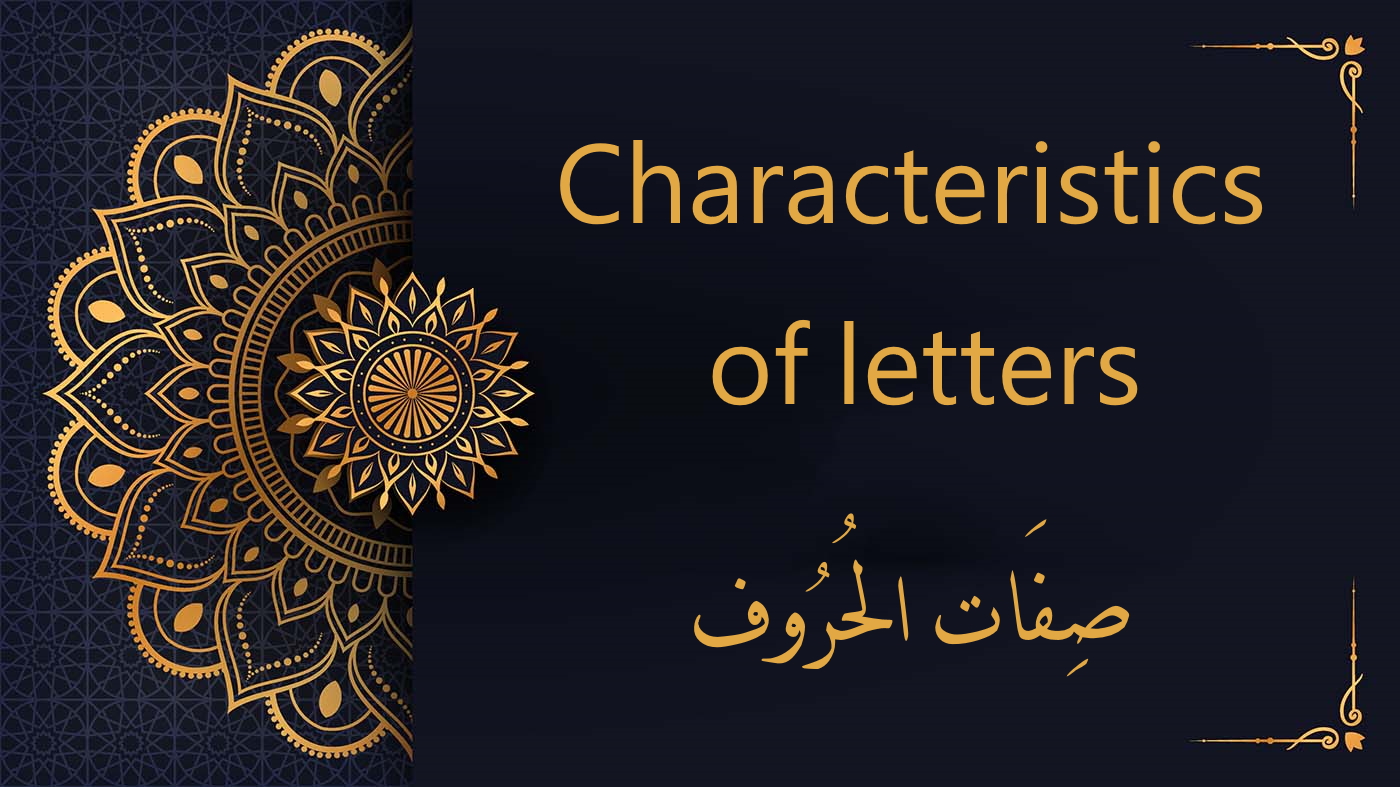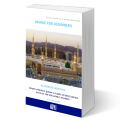
Exploring the Nuances: The Characteristics of Arabic Letters (Sifaat al-Huruf)
Delving into Sifaat: Understanding the Characteristics of Letters
After examining the exit points or “Makharij” of the Arabic letters, it’s essential to delve deeper into their distinctive features or “Sifaat (صِفَات)”. While several letters may share the same exit point, their unique characteristics set them apart during pronunciation. For instance:
- Some letters are soft, others are more pronounced.
- Some require a breath, others are silent.
The Importance of Studying Sifaat al-Huruf
There are three key advantages to understanding these characteristics:
- Differentiation: It helps differentiate between letters that share the same exit point.
- Precision in Pronunciation: You can distinguish between thin (muraqaqa) and emphatic (mufakhama) letters. This becomes especially useful when applying the rule of “assimilations” or “al-idgham”.
- Refinement: It enhances pronunciation accuracy. A subtle shift in a letter’s characteristic can transform its sound; for example, letting out a breath while pronouncing د makes it sound like ت.
By mastering the Sifaat, we ensure the purity and distinctiveness of each letter.
How Many Sifaat Should We Study?
The exact number of sifat varies according to scholars. While Imam Ibn Al Jazary believed there are 17 essential sifat, others suggest numbers ranging from 14 to 44. For our study, we’ll focus on the widely accepted 17 essential sifat.
The Distinctive Features of Letters
Letters can be grouped based on their distinguishing features:
- Letters with Opposing Characteristics (الصِفَاتُ المُتَضادَة): These letters possess contrasting characteristics.
- Letters with Unique Characteristics: These do not have opposing features.
Part I: Characteristics of Arabic Letters with Contrasting Attributes
These letters are defined by specific attributes, each of which places the letter in a distinct category. Five main attributes help define a letter:
- The presence (or absence) of breath during pronunciation.
- Continuity (or disruption) of sound during pronunciation.
- The tongue’s distance (or closeness) to the palate during pronunciation.
- The letter’s attachment (or detachment) from the palate.
- The letter’s pronunciation using the tip of the lips or the tongue.
1. Al Hams - الْهَمْسُ vs al Jahr - الجَهْرُ
A. Al Hams (الْهَمْسُ) - The Whisper
In Arabic, al-hams translates to “the whisper.” It pertains to a flow of air accompanying the pronunciation of these 10 letters:
ف – ح – ث – ه – ش – خ – ص – س – ك – ت
To memorize these letters, recall the phrase:
فَحَثَّهُ شَخْص سَكَت
Technically, the flow of air continues even after pronouncing the letter, especially pronounced when the letter is sakeena (bearing a sukoon).
Examples:
الرَّحْمن – بِاسْمِ
Notes:
For the letters ت and ك, the air flow is significant when they’re sâkina: ت and ك. The flow is faint when they have vowel marks (mutaharika). Be cautious with ت’s pronunciation; overemphasis might make it sound like س.
Examples:
تُتْلَى – سُيَّرَتْ – كُوِّرَتْ
B. Al Jahr (الجَهْرُ) - The Loud Voice
In Arabic, al-Jahr denotes “the loud voice.” It relates to a halt in the airflow while pronouncing the remaining 19 letters:
ا – ب – ج – د – ذ – – ز- ض
ط – ظ – ع -غ -ق – ل – م – ن – و -ء – ي
To remember these letters, use the mnemonic:
عَظُمَ وَزْنُ قَارِئٍ غَضٍّ ذِي طَلَبَ جِد
In this case, the breath halts immediately after the letter is articulated.
Examples:
الحَمْدُ – يُؤْمِنُونْ – نَعْبُد
2. Ash-shidda - الشِّدَّةُ, al baynya - البَينية, ar Rakhawa - الرَّخَاوَةُ
A. Ash-shidda (الشِّدَّةُ) - The Intensity
In Arabic, “al-shidda” signifies intensity. It denotes a cessation of sound flow during the pronunciation of these 8 letters:
ت – ك -ب – ط -ق – د – ج – أ
To remember these letters, use the phrase:
أَجِدْ قَطٍ بَكَتْ
Technically, the sound is interrupted as it leans on its makhraj.
Examples:
انشَقَّتِ – تُبْلَى – رَكَّبَكَ – يَجْتَبِي
B. Al baynya (البَينية) or At-tawasut (التَّوَسُط)
This sound characteristic is intermediate. It’s neither as abrupt as Ash-shidda nor as elongated as Ar-rakhawa. The following 5 letters exhibit this quality:
ر – م – ع – ن – ل
To remember these letters, use the phrase:
لِنْ عُمَر
Technically, the sound doesn’t halt abruptly nor does it extend for a long duration. It strikes a balance between Ash-shidda and Ar-rakhawa.
Examples:
الأرْضِ – الدِّيْنِ – نَعْبُدُ – الحَمْدُ
C. Ar Rakhawa (الرَّخَاوَةُ) - The Flexibility
In Arabic, “al-rakhawa” translates to flexibility. It’s the continuation of sound as you pronounce the remaining 15 letters:
و – ه – ف – غ – ظ – ض -ص ش -س -ز – ذ – خ – ح – ث – ا
Technically, the sound of the letter is elongated.
Examples:
أَظْلَمَ – نَسْتَعِيْنُ – يُغْنِيكُمُ – الرَّحْمَنِ
Note: Sound duration varies:
- Ar-rakhawa (الرَّخَاوَة): Elongated sound
- Al baynya (البَينية): Intermediate sound duration
- Ash-shidda (الشِّدَّةُ): Interrupted sound
3. Al-istiala - الاِسْتِعَلاءُ vs al-istifal - الاسْتِفَالُ
A. Al-istiala (الاِسْتِعَلاءُ)
Meaning: In Arabic, “al-istiala” refers to “elevation.”
Explanation: Pronunciation of specific letters exerts upward pressure on the palate. These are called emphatic letters (al-tafkheem – التَّفْخِيم). All these letters are considered emphatic due to their pronunciation characteristics.
Letters: There are 7 letters that undergo this pressure:
ظ – خ – ص – ض -غ – ط – ق
They can be remembered through the sentence:
خُصَّ ضَغْطٍ قِط
Degrees of Tafkheem:
-
- When the letter bears a fatha, followed by an alif
- When the letter bears a fatha but not followed by Alif
- When the letter bears a damma
- When the letter bears a sukoon
- When the letter bears a kasra
B. Al-istifal (الاسْتِفَالُ)
Meaning: In Arabic, “al-istifal” signifies “lowering.”
Explanation: Pronunciation of these letters applies downward pressure on the palate, lightening them (equivalent to al-tarqeeq – التَّرْقِيق).
Letters: The remaining 22 letters include:
ا – ب – ت – ث – ج – ح – د – ذ – ر -ز -س – ش – ع – ف – ك – ل – م – ن – ه – و -ء – ي
Special Mention: Three letters can sometimes be emphatic and sometimes light:
ر – ل – ا
C. Al-itbaq (الإِطْبَاق) vs. Al infitah (الإِنْفِتَاح)
Al-itbaq (الإِطْبَاق)
Meaning: Derived from a verb meaning “to stick.”
Explanation: Pronunciation of these letters involves part of the tongue sticking to the palate.
Letters:
ظ – ط – ض -ص
Al infitah (الإِنْفِتَاح)
Meaning: “Separation.”
Explanation: Pronunciation leaves an opening between the tongue and the palate.
Letters:
ا – ب – ت – ث – ج – ح – خ – د – ذ -ر -ز – س – ش – ع – غ – ف – ق – ك – ل – م – ن – ه – و – ء – ي
D. Al-idhlaq (الإِذْلاقُ) vs. Al ismat (الإِصْمَات)
Al-idhlaq (الإِذْلاقُ)
This category, known as “sifat,” isn’t always considered primary. Some scholars might not even categorize them under “sifat.”
Description: Refers to letters pronounced with ease and fluidity.
Letters (6 in total):
ب – ل – م – ن – ر – ف
Mnemonic Sentence:
فَرَّ مِنْ لُبٍّ
Technicality: The pronunciation involves the tip of the tongue or the lips.
Al ismat (الإِصْمَات)
Description: These letters exhibit a certain heaviness during their pronunciation.
Letters (23 in total):
ا – ت – ث – ج – ح – خ – د – ذ – ز – س – ش – ص – ض – ط – ظ – ع -غ – ق – ك – ه – و -ء – ي
Technicality: Pronunciation doesn’t involve pressing against the tip of the tongue or lips.
Part II: Letters with distinctive characteristics having no opposites (الصِفَات غَيْر المُتَضادَة)
1. As-Safeer (الصَفِير)
Definition: In Arabic, “as-safîr” translates to “whistling.”
Characteristics:
It’s a robust phonetic feature.
Produces a whistle-like sound.
Letters:
ص: Resembles the sound made by a goose.
ز: Mirrors the buzzing of a bee.
س: Evokes the chirping of a cicada.
Technical Note: The sound is produced with an emission between the lips, earning these letters the title “the whistling letters.”
2. Al-Qalqala (القَلْقَلَة)
Definition: “Al-Qalqala” in Arabic denotes restlessness, instability, or disturbance.
Characteristics:
- It is a pronounced impact resulting from the articulation of a letter in a “sukoon” state.
- It arises due to the swift separation of two articulation points without opening the mouth or involving lip or jaw movements.
- This trait is integral to the Tajweed rules.
Letters:
ق – ط – ب – ج – د
Mnemonic Sentence:
قُطُبٌ جَدٍ
Technical Note: There’s a distinct bounce when a letter possesses a “sukoon.” The intensity of the qalqala varies:
- Strongest: ط
- Intermediate: ج
- Least Pronounced: د – ب – ق
When any of these letters appear in the middle of a word or sentence, a softer qalqala is produced, known as “qalqala sughra.”
Example
لَمْ يَلِدْ وَلَمْ يُولَدْ
He neither begets nor is born (112:3)
Note: If a letter is positioned at the end of a verse and we pause on it, a pronounced qalqala is produced, termed as “qalqala kubra.”
لَمْ يَلِدْ وَلَمْ يُولَدْ
He neither begets nor is born (112:3)
Note: The resonance of the letter intensifies when it is repeated at the end of a recitation. This is referred to as “al-qalqala al-akbar.”
تَبَّتْ يَدَا أَبِي لَهَبٍ وَتَبَّ
May the hands of Abu Lahab be ruined, and ruined is he. (111:1)
3. Al-leen - اللِّيْن
Definition: “Al-leen” in Arabic translates to “gentleness.” It denotes a soft and effortless pronunciation.
Characteristics:
- It’s a subtle phonetic feature.
- Primarily associated with the letters waw (و) and ya (ي) when they bear a sukoon (ـْ) and are preceded by a fatha (ـَ).
Example:
الَّذِي أَطْعَمَهُم مِّن جُوعٍ وَآمَنَهُم مِّنْ خَوْفٍ
Who has fed them, [saving them] from hunger and made them safe, [saving them] from fear. (106:4)
وَيْلٌ لِّكُلِّ هُمَزَةٍ لُّمَزَةٍ
Woe to every scorner and mocker (104:1)
4. Al inhiraf - الإِنْحِراف
Definition: “Al-inhirâf” translates from Arabic as “deviation.” It pertains to the alteration of the sound of certain letters from their original points of articulation.
Characteristics:
- This is a pronounced phonetic feature.
- It is associated specifically with the letters:
- ل (lam)
- ر (raa)
Technical Note:
- When articulating these letters, there’s a tendency for their sounds to veer from their designated articulation points (makharij) and blend into the points of adjacent letters.
- For the letter ل (lam), the sound deviates towards the sides of the tongue.
- For the letter ر (raa), the sound shifts from the tongue’s tip further back towards the region between its tip and middle.
5. At-takreer - التَّكْرِير
Definition: “At-takrîr” in Arabic signifies “repetition.” It describes the vibration of the tongue’s tip when pronouncing the letter:
ر (raa)
Characteristics:
- It’s a pronounced phonetic trait.
- The emphasis is on the vibrating or rolling of the tongue’s tip during the articulation of the letter.
Technical Note:
- The intention behind learning this characteristic is to ensure it’s not overly emphasized, as excessive vibration can lead to mispronunciation.
- When pronouncing the ر (raa), the tongue should tap the palate just once. In cases where the letter is emphasized or “mushadada” (رّ), the extended vibration, or takreer, should be restrained by halting the tongue’s movement.
At tafashee - التَّفَشِي
Definition: “At-tafashee” translates from Arabic as “propagation.” It describes the dispersal of air within the mouth during the pronunciation of a specific letter.
Characteristics:
- It’s a distinct phonetic trait.
- Exclusively associated with the letter:
ش (sheen)
Technical Note:
- When articulating the letter ش (sheen), there’s a notable propagation or diffusion of breath throughout the mouth.
Al istitala - الإِسْتِطَالَة
Definition: In Arabic, “al-istitala” signifies “elongation.” It pertains to the extended sound duration during the pronunciation of a particular letter.
Characteristics:
- It’s a subtle phonetic trait.
- It is primarily associated with the letter:
ض (dad)
Technical Note:
- The articulation of the letter ض (dad) involves an elongation, reaching towards the articulation point (makhraj) of the letter ل (lâm).
End of Tajweed Rules Lesson
Thank you for completing this lesson on tajweed rules. Insha’Allah, our next session will delve into the definite article “al” (ال).
Interested in Further Learning?
Al-dirassa Institute provides an excellent opportunity to master the tajweed rules under the guidance of a qualified instructor. If you’re keen to expand your knowledge, please feel free to reach out to us.
Chosen and Trusted by Thousands of Satisfied Learners
Discover the experiences of our delighted clients who have thoroughly enjoyed utilizing this standout feature.
Alhamdulillah I‘m very pleased with the arabic and Qur’an lessons I receive from teacher Umm Tasneem and I‘m also content with the al-dirassa administration team who were very quick in answering any questions I had. In a month I progressed a lot and I cannot wait to continue my studies with al-dirassa. May Allah reward everyone at al-dirassa.
 Verified review - view original
Verified review - view original
My Qur’an teacher is fantastic, she teaches me in a loving and kind way where I look forward to the lessons and learn so much. My Arabic teacher is equally as nice and has a lot of patience with me, she has great expertise in the field and I’ve progressed really quickly with her. Thank you Al-dirassa!
 Verified review - view original
Verified review - view original
Book your free trial lesson
Don’t want to go through the translation anymore?
30 free minutes with your qualified Egyptian teacher.




